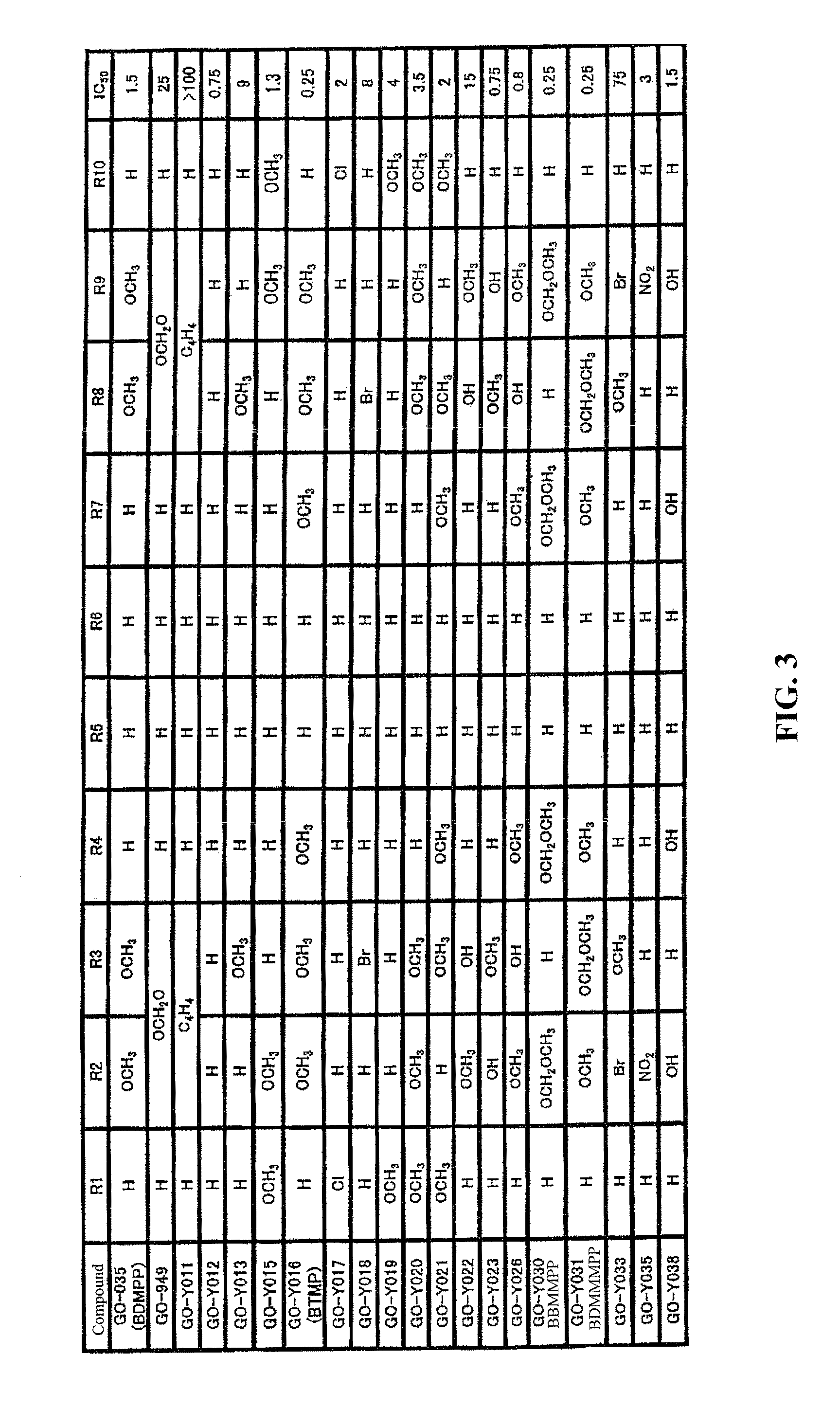Bis(arylmethylidene)acetone compound, anti-cancer agent, carcinogenesis-preventive agent, inhibitor of expression of Ki-Ras, ErbB2, c-Myc and Cycline D1, β-catenin-degrading agent, and p53 expression enhancer
a technology of acetone and arylmethylidene, which is applied in the field of new pharmacological agents, can solve the problems of poor solubility of curcumin and difficult improvement of the activity of inhibiting cell growth, and achieve the effects of inhibiting the growth of cancer cells, preventing carcinogenesis, and high activity in inhibiting cancer cell growth
- Summary
- Abstract
- Description
- Claims
- Application Information
AI Technical Summary
Benefits of technology
Problems solved by technology
Method used
Image
Examples
example 1
Step A
[0079]Symmetric compounds can be obtained by the action of acetone and an aryl aldehyde (1:2) in an aqueous solution of ethanol and 10% sodium hydroxide at room temperature. When the solubility of the aryl aldehyde in ethanol is exceptionally poor, the aryl aldehyde can be dissolved by using a small amount of tetrahydrofuran. When the aryl aldehyde has hydroxyl substituent groups, the reaction is performed after properly protecting these groups using ethoxyethyl, tetrahydropyran, methoxymethyl, or other groups. The products are stable under general conditions for deprotecting these groups.
Step B
[0080]A methyl ketone compound that is an intermediate of an asymmetric compound can be obtained using the acetone and aryl aldehyde of Step A in a 4:1 ratio.
Step C
[0081]An asymmetric compound can be obtained using the methyl ketone compound and an aryl aldehyde in a 1:1 ratio under the conditions of Mixture 1.
Synthesis of methyl (4-formyl-2,6-dimethoxyphenoxy)-acetate
[0082]To a solutio...
example 2
Synthesis of (3E)-4-(3,5-dimethoxy-4-prop-2-ynyloxy-phenyl)-but-3-en-2-one
[0088]To an aqueous 10% sodium hydroxide solution (4.3 mL, 1.0 M) was added slowly dropwise a mixture of an ethanol (4.3 mL, 1.0 M) solution of 3,5-dimethoxy-4-prop-2-ynyloxybenzaldehyde (0.95 g, 4.3 mmol) and acetone (1.27 mL, 17.3 mmol), and the resultant mixture was stirred for 1 hour at room temperature, followed by addition of 10% hydrochloric acid. The mixture was then extracted with ethyl acetate, washed with saturated saline, dried over magnesium sulfate, and evaporated under reduced pressure to give a residue which was subjected to silica gel chromatography. A white solid (605 mg, 54%) was obtained from an ethyl acetate / hexane eluent (1:1 v / v).
Synthesis of (1E,4E)-1-(3,5-dimethoxy-4-methoxymethoxyphenyl)-5-(3,5-dimethoxy-4-prop-2-ynyloxy-phenyl)penta-1,4-dien-3-one (GO-Y063)
[0089]To an aqueous 10% sodium hydroxide solution (0.384 mL, 1.0 M) was added slowly dropwise an ethanol (0.384 mL, 1.0 M)-tetrah...
example 3
[0090]The compounds below were synthesized in the same manner as Examples 1 and 2.
(1) (1E,4E)-1,5-bis-(3,4-bismethoxymethoxyphenyl)penta-1,4-dien-3-one (GO-Y035)
[0091]Yellow crystals (MeOH): mp 86 to 88° C.; IR(CHCl3) 1646, 1618 cm−1; 1H-NMR (400 MHz, CDCl3) δ 7.69 (2H, d, J=15.9 Hz) 7.21 (2H, dd, J=8.2, 1.7 Hz), 7.15 (2H, d, J=1.69 Hz), 6.96 (2H, d, J=15.9 Hz), 6.90 (2H, d, J=8.2 Hz), 3.95 (6H, s) 3.93 (6H, s); 13C-NMR (100 Hz, CDCl3) δ 188.0, 175.0, 148.6, 142.4, 135.0, 127.3, 123.1, 122.5, 110.7, 109.5, 72.8, 55.8, 55.7; MS m / z 354 (M+, 100%); HRMS calcd for C21H22O5 354.1467. found 354.1460.
(2) (1E,4E)-1,5-bis-benzo[1,3]dioxol-5-yl-penta-1,4-dien-3-one (GO-949)
[0092]1H-NMR (400 MHz CDCl3) δ=7.64 (2H, d, J=16.0 Hz), 7.12 (2H, d, J=1.7 Hz), 7.09 (2H, dd, J=8.0, 1.7 Hz), 6.88 (2H, d, J=15.7 Hz), 6.83 (2H, d, J=8.0 Hz), 6.02 (4H, s).
(3) (1E,4E)-1,5-dinaphthalen-2-yl-penta-1,4-dien-3-one (GO-Y011)
[0093]Pale yellow powder (xylene), mp=244 to 246° C.; IR (CHCl3): 1648 cm−1; 1H-NMR (400...
PUM
| Property | Measurement | Unit |
|---|---|---|
| temperature | aaaaa | aaaaa |
| temperature | aaaaa | aaaaa |
| temperature | aaaaa | aaaaa |
Abstract
Description
Claims
Application Information
 Login to View More
Login to View More - R&D
- Intellectual Property
- Life Sciences
- Materials
- Tech Scout
- Unparalleled Data Quality
- Higher Quality Content
- 60% Fewer Hallucinations
Browse by: Latest US Patents, China's latest patents, Technical Efficacy Thesaurus, Application Domain, Technology Topic, Popular Technical Reports.
© 2025 PatSnap. All rights reserved.Legal|Privacy policy|Modern Slavery Act Transparency Statement|Sitemap|About US| Contact US: help@patsnap.com



